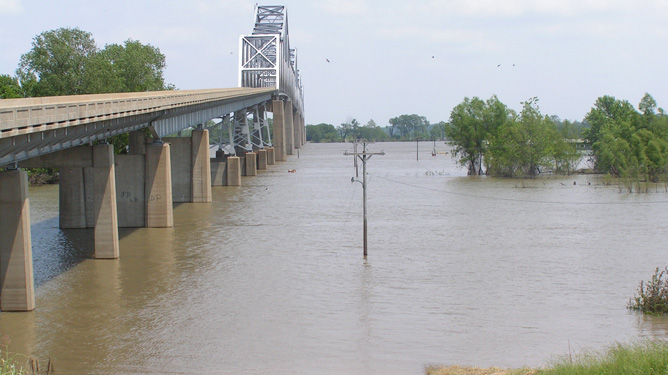OXFORD, Miss. – Hurricane Isaac’s path may have spared the Mississippi Delta recently, but residents in the 12-county area know from experience that devastating flash floods can occur without warning.
The Mississippi Emergency Management Agency has funded a University of Mississippi project to assist local emergency response agencies in preparing for flood-related disasters.
“Flood Risk Assessment and Vulnerability Associated with Mississippi River Levees” is a $470,776 study that began in June 2011 and continues through April 2013. Geological and civil engineering faculty, along with the university’s Mississippi Mineral Resources Institute staff and geological engineering graduate students, are working closely with the two Mississippi levee boards and U.S. Army Corps of Engineers personnel in Memphis and Vicksburg to gather and verify data that would be useful when water levels rise along and around the Mississippi River.
“We’ve seen the river at both its highest and lowest levels,” said Charles Swann, MMRI associate director and principal investigator for the flood mitigation project. “Our goal is to put together all the information that would be of use in the event of flooding.”
Swann and his team have been locating levees, areas of flood mitigation and characteristics of repetitive loss properties in the area. When the study is completed, the group will make recommendations to MEMA about how to reduce vulnerabilities in the area.
“I’ve been locating and mapping the major levees along the Mississippi River,” said Thomas Chapman “Chap” Brackett, an Ole Miss graduate student in geological engineering from Savannah, Ga. “Most of these were built after the flood of 1927 and are still holding up.”
While Brackett is providing emergency response personnel with valuable geospatial maps of the region, he is also obtaining technical information to include in his thesis. He is scheduled to graduate in December.
MMRI research associate Jeremy Dew has been studying critical facilities such as hospitals, power plants, law enforcement departments, jails and government facilities. Using satellite imaging and site visits, Dew is determining which buildings on a list provided by MEMA still exist and how viable they are.
“In a few cases, we didn’t have correct GPS points,” Dew said. “Once we have all the correct information, it will be included in the GIS data given back to MEMA. Emergency response personnel in each county will also receive a copy.”
Flood vulnerability analysis is being studied by Louis Zachos, assistant professor of geology and geological engineering.
“We’re focusing on the susceptibility of both rural and urban communities to the impact from flooding caused by failure of existing levee systems,” Zachos said. “By considering the social, economic, environmental and physical vulnerability components of each city, township or community, we can rank their relative degree of vulnerability in census blocks. They will then be prioritized for mitigation or emergency response.”
Chung Rak Song, associate professor of civil engineering, is studying the vulnerability of levees to earthquake hazard.
“Under certain conditions, such as an earthquake, soils lose strength and turn into a semi-liquid,” said Song, who has studied levees in New Orleans. “This liquefaction can cause land to sink and create foundation problems for whatever is built upon them.”
Other geological graduate students involved in the levee project are Laura Dalton of Corinth and Scott Milo of Leesburg, Va.
The main objective is simply to keep people safe in a flood emergency, Swann said.
“With the information we provide to MEMA, they should have some better tools to work with. Should a flood arise, folks in the Mississippi Delta will be safer and emergency response quicker,” Swann said. “At such times, minutes can mean the difference between life and death.”
For more information, visit the Mississippi Mineral Resources Institute.
